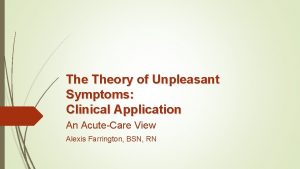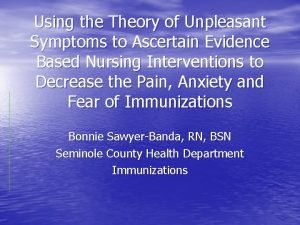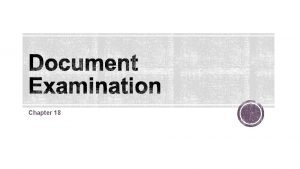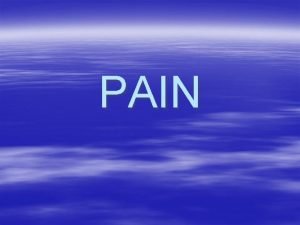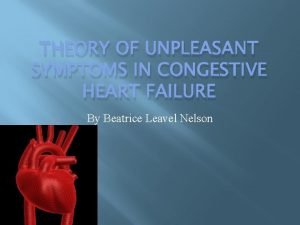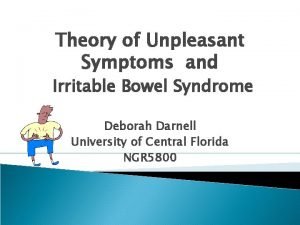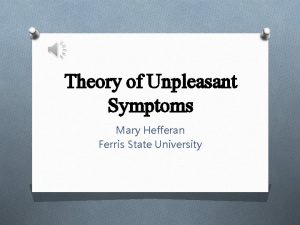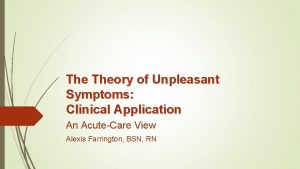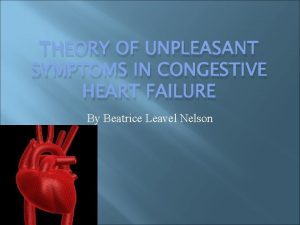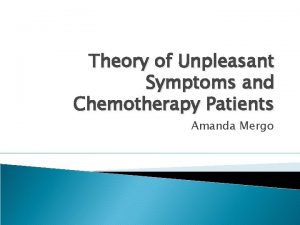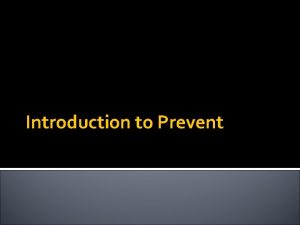Using the Theory of Unpleasant Symptoms to Ascertain















- Slides: 15

Using the Theory of Unpleasant Symptoms to Ascertain Evidence Based Nursing Interventions to Decrease the Pain, Anxiety and Fear of Immunizations Bonnie Sawyer-Banda, RN, BSN Seminole County Health Department Immunizations

Background • Worldwide, 800 million immunizations are given to children yearly (WHO, 2000). • Florida children receive at least 21 injections by the time they enter kindergarten (CDC, 2011). • 10% of the population has “needle phobia” (Taddio, 2008). • This phobia can be traced back to childhood immunizations for 5% of afflicted individuals (Gaskell, Binns, Heyhoe, and Jackson, 2005). • The pain anticipated by children who are going to receive immunizations causes distress and anxiety for the child as well as for the parent of the child and the health care provider.

Why is the fear of needle pain a problem? • Many parents are overcome with feelings of guilt, helplessness and duplicity for allowing this fearful procedure to happen to their child (Gaskell et al. , 2005). The consequence of these parental reactions may be seen in their delaying immunizations for their children (Taddio, 2008). • The fear of needles can lead to the avoidance of medical care, dental procedures, blood donations, poor immunization compliance and poor management of diabetes (Taddio, 2008). • Nurses inflict more pain than other health care providers (Nagy, 1999)and they experience stress when they must administer immunizations to children that resist needle injections (Ives and Melrose, 2010). • Many parents delay immunizations because of the pain experienced by their child. The chances of vaccine preventable disease outbreaks increase when there is an overall reduction of community immunity (Luthy, Beckstrand Peterson 2009; Taddio, Manley, Potash, Ipp, Sgro and Shah 2008).

Problem statement • The fear of injection pain causes anxiety and distress in patients, parents and health care providers.

Significance • Needle fear dominates the health care visits and prevents the health care provider from building a rapport with the child and addressing other health maintenance issues (Schechter, Zempsky, Cohen, Mc. Grath, Mc. Murty and Bright , 2007) • Individuals that are needle phobic typically avoid medical and dental care which can cause an impediment in the health care system (Hamilton, 1995). • Intentional under-vaccination can cost public health thousands of dollars to control outbreaks of vaccine preventable illnesses as well as undermining disease elimination (Sugarman, Barskey, Delea, Ortega-Sanchez, Bi, Ralston, Rota, Waters-Montijo and Le. Baron, 2010).

Specific Aims • By applying theory of unpleasant symptoms, the author will offer evidence based interventions to decrease the anxiety, fear and pain of administering injections. This could conceivably reduce the number of patients that develop needle phobia and decrease parents’ and patient’s fear which will subsequently increase immunization rates of children and adults.

Theory of unpleasant symptoms • The purpose of this middle range theory was to design a framework that would help guide research in understanding how to prevent, reduce and make more bearable, those unpleasant symptoms and the negative effects that they potentially can bring about (Lenz, Suppe, Gift, Pugh and Milligan, 1995). • The three major concepts of theory are the symptoms, the influencing factors and the performance consequences. The theory proposed that the manifestations of an unpleasant symptom were influenced by physiological, psychological and situational factors (Lenz and Pugh, 2008). • In their seminal work, Lenz, Suppe, Gift, Pugh and Milligan state that “the theory of unpleasant symptoms can be used to identify preventive interventions to modify some of the factors that produce symptoms or to develop innovative treatments that can be applied across symptoms when they occur. ” (1995, p. 11). • The TOUS can be used as a guide for looking at the symptoms of anxiety, fear and pain from needle procedures common in most patients as well as precipitating factors that influence the symptoms. We can also examine the psychological, physiological and situational factors that can decrease or reduce the effects of the pain perception.

Interventions that decrease pain and anxiety • Physiological – What the body senses • Psychological – What the mind believes • Situational – What is in the surrounding space

Physiological • Touch, temperature or vibratory stimuli (Davis, 1993) – Touch – apply direct pressure 10 seconds prior to injection – Temperature – apply ice or vapocoolant (Mawhorter, et al. , 2004) to injection site prior to injection – Vibration – apply vibration between the pain and the brain to block nerve impulses (Buzzy) – EMLA cream • Correct needle length (longer IS better!) (Taddio, 2008). • Administer the least painful vaccine first (Ipp, Parkin, Lear, Goldblach and Taddio, 2009). – Always give PCV 13, MMR and HPV last. • Adequate hydration and glucose levels in adolescents – Popsicles, juice, lollipops

Psychological • Taste, suckling and skin-to-skin contact (Tansky and Lindberg, 2010) – Sugar solution in babies <12 mo. decreases cry time – Let babies breast feed or use pacifier – Skin to skin or kangaroo care has shown to decrease cry time • Distractions such as breathing, coughing and laughing (Cassidy, 2002). – Coughing before shot – Blow away the pain – pinwheels and soap bubbles – Laughter decreases pain perception • Education and information (Boivin, Poupon-Lemarquis, Iraqi, Fay, Schmitt and Rossignol, 2008). – Explain what you are doing and why – Explain to parent why it is important to remain calm

Situational • A “calming and child-friendly environment” (Gaskell, 2005, p. 26). – Decorations and toys • Non-procedural talk (Blount, Devine, Cheng, Simons and Hayutin, 2008). – – – Baby talk Do not say “shot” Praise the child • Give the vaccines quickly – There is no difference in perceived pain in giving the shots slowly vs. quickly (Mitchell and Whitney, 2001). • Enlisting the parent’s assistance in providing distraction techniques to the child indirectly helps to lower the stress level of the parent and child (Cohen, Blount and Panopoulos, 1997). – Reading, telling stories, asking questions

Summary • Using theory of unpleasant symptoms and evidence based research, the influencing factors that relate to the physiological, psychological and situational interventions have been explored. Using a combination of these interventions, the elements of duration, intensity, quality, and distress can be decreased in the symptoms of pain, fear and anxiety. When these symptoms have been lessened, there should be positive performance consequences with outcomes of higher immunization rates and fewer cases of needle phobia. Patients expect nursing care that is competent. Using available interventions to make the patient more comfortable increases the perception of competency thereby achieving better results for the patient and the agency or institution.

Which method to use? • Not all methods work for everyone. • Try a combination of a couple of methods • Some methods are more appropriate for certain ages

References • • • • • • Blount, R. , Devine, K. , Cheng, P. , Simons, L. , & Hayutin , L. (2008). The impact of adult behaviors and vocalizations on infant distress during Blount, R. , Devine, K. , Cheng, P. , Simons, L. , & Hayutin, L. (2008). The impact of adult behaviors and vocalizations on infant distress during immunizations. Journal of Pediatric Psychology, 33(10), 1163 -1174. doi: 10. 1093/jpepsy/jsn 030 Boivin, J. , Poupon-Lemarquis, L. , Iraqi, W. , Fay, R. , Schmitt, C. , & Rossignol, P. (2008). A multifactorial strategy of pain management is associated with Boivin, J. , Poupon-Lemarquis less pain in scheduled vaccination of children. A study realized by family practitioners in 239 children aged 4 -12 years old. Family Practice - an International Journal, 25(25), 423 -429. doi: 10. 1093/fampra/cmn 069 Centers for Disease Control and Prevention. (2011). The recommended immunization schedules for persons aged 0 through 18 years. Retrieved 03/14, 2011, from http: //www. cdc. goc/vaccines/recs/schedules/downloads/child/0 -6 yrsschedule-bw. pdf Cohen, L. , Blount, R. , & Panopoulos , G. (1997). Nurse coaching and cartoon distraction: An effective and practical intervention to reduce child, parent, Cohen, L. , Blount, R. , & Panopoulos, G. (1997). Nurse coaching and cartoon distraction: An effective and practical intervention to reduce child, parent, and nurse distress during immunizations. Journal of Pediatric Psychology, 22(3), 355 -370. Davis, P. (193). Opening up the gate control theory. Nursing Standard, 7(45), 25 -27. Gaskell, S. , Binns , F. , Heyhoe, M. , & Jackson, B. (2005). Taking the sting out of needles: Education for staff in primary care. Paediatric Nursing, 17(4), Gaskell, S. , Binns, F. , 24 -28. Hamilton, J. (1995). Needle phobia: A neglected diagnosis. Journal of Family Practice, 41(2), 169(7). Ipp, M. , Parkin, P. , Lear, N. , Goldbach, M. , & Taddio, A. (2009). Order of vaccine injection and infant pain response. Archives Pediatric and Adolescent Ipp, M. , Parkin Medicine, 163(5), 469 -472 Ives, M. , & Melrose, S. (2010). Immunizing children who fear and resist needles: Is it a problem for nurses? Nursing Forum, 45(1), 29 -39. Lenz, E. , & Pugh, L. (2008). Theory of unpleasant symptoms. In M. J. Smith, & P. Liehr (Eds. ), Middle range theory for nursing (2 nd ed. , pp. 159 -182). Lenz, E. , & Pugh, L. (2008). Theory of unpleasant symptoms. In M. J. Smith, & P. Liehr (Eds. ), New York: Springer Publishing Company. Lenz, E. , Suppe , F. , Gift, A. , Pugh, L. , & Milligan, R. (1995). Collaborative development of middle-range nursing theories: Toward a theory of unpleasant Lenz, E. , Suppe, F. , Gift, A. , Pugh, L. , & Milligan, R. (1995). Collaborative development of middle-range nursing theories: Toward a theory of unpleasant symptoms. Advances in Nursing Science, 17(3), 1 -13. Luthy, K. , Beckstrand, R. , & Peterson, N. (2009). Parental hesitation as a factor in delayed childhood immunization. Journal of Pediatric Health Care, Luthy, K. , Beckstrand 23(6), 388 -393. Mawhorter, S. , Daugherty, L. , Ford, A. , Hughes, R. , Metzger, D. , and Easley, K. (2004) Topical vapocoolant quickly and effectively reduces vaccine. Mawhorter, S. , Daugherty, L associated pain: Results of a randomized, single-blinded, placebo-controlled study. Journal of Travel Medicine. 11(5). 267 -272. Mitchell, J. R. and Whitney, F. W. (2001) The effect of injection speed on the perception of intramuscular injection pain: A clinical update. American Association of Occupational Health Nurses Journal. 49(6) 286 -92 Nagy, S. (1999). Strategies used by burns nurses to cope with the infliction of pain on patients. Journal of Advanced Nursing, 29(6), 1427 -1433. Schechter, N. L. , Zempsky , W. , Cohen, L. , Mc. Grath, P. , Mc. Murty, M. , & Bright, N. S. (2007). Pain reduction during pediatric immunizations: Evidence. Schechter, N. L. , Zempsky, W. , Cohen, L. , Mc. Grath, P. , based review and recommendations. Pediatrics, 119(5), e 1184 -e 1198. Sugarman, D. , Barskey, A. , Delea, M. , Ortega-Sanchez, I. , Bi, D. , Ralston, K. , . . . Le. Baron, C. (2010). Measles outbreak in a highly vaccinated Sugarman, D. , Barskey population, San Diego, 2008: Role of the intentionally undervaccinated. . Pediatrics, 125(4), 747 -755. Tansky, C. , & Lindberg, C. (2010). Breastfeeding as a pain intervention when immunizing infants. The Journal for Nurse Practitioners, 6(4), 287 -295. Taddio, A. (2008). Proceedings of the workshop. Conquering Pain: The Hidden Cost of Immunization, University of Toronto, Canada. 1 -32. World Health Organization Secretariat of the Safe Injection Global Network. (2004). Safety of injections. Retrieved 03/05, 2011, from http: //www. who. int/injection_safety/about/resourses/en/Question. And. Answers. Injection. Safety. pdf

THE END
 Theory of unpleasant symptoms in practice
Theory of unpleasant symptoms in practice The theory of unpleasant symptoms
The theory of unpleasant symptoms What are the methods of departmental accounting
What are the methods of departmental accounting Affiliated ascertain attainment
Affiliated ascertain attainment The style of handwriting is a means to ascertain
The style of handwriting is a means to ascertain Tender nipples sign of early pregnancy
Tender nipples sign of early pregnancy Fall was inevitable and unpleasant
Fall was inevitable and unpleasant Wilda pain assessment
Wilda pain assessment Stress caused by an unpleasant situation is
Stress caused by an unpleasant situation is Hình ảnh bộ gõ cơ thể búng tay
Hình ảnh bộ gõ cơ thể búng tay Ng-html
Ng-html Bổ thể
Bổ thể Tỉ lệ cơ thể trẻ em
Tỉ lệ cơ thể trẻ em Voi kéo gỗ như thế nào
Voi kéo gỗ như thế nào Glasgow thang điểm
Glasgow thang điểm Chúa yêu trần thế
Chúa yêu trần thế
